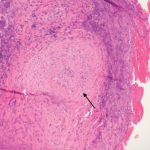“The inflammation can be intense enough to lead to a collapse of the nasal bridge,” known as saddle nose, he said. “It’s a gradual process and can take years to progress. Patients may not even notice the change.”
Other GPA symptoms include strawberry gingiva sores, subglottic stenosis, and granulomas that develop in the back of the eyes, causing double vision. GPA may also cause bleeding in the lungs from inflammation of the alveoli.4
“This will be a very dramatic presentation. They will be out of breath very quickly and even coughing up blood,” Dr. Springer said. Kidney involvement will not produce noticeable symptoms until the disease is very advanced. On urinalysis, look for red blood cell casts in the urine. GPA patients may present with a dropped hand or foot caused by mononeuritis multiplex, joint pain without swelling, stomach pain after eating or blood in the stool, he said.
Conditions Can Be Similar
MPA is a necrotizing vasculitis with few or no immune deposits that mostly affects the small vessels, with glomerulonephritis and pulmonary capillaritis as common problems, said Dr. Springer. Like GPA, it is ANCA positive in 80–90% of cases, and may be accompanied by alveolar hemorrhage, renal failure, and skin, peripheral nervous system or gastrointestinal system involvement.
“Some people have questioned [whether] these two diseases, because they have so many similar features, are a spectrum of the same disease, but they seem to have distinct genetic features,” said Dr. Springer.5 Unlike GPA, MPA has no ENT involvement or granulomas, and fewer relapses.
EGPA is an eosinophil-rich, necrotizing, granulomatous inflammation that often affects the small to medium vessels of the respiratory tract.6 It is associated with asthma and eosinophilia, said Dr. Springer.
EGPA has three phases that may overlap. Patients may first have allergic rhinitis, nasal polyposis, sinusitis or asthma. In the second phase, high amounts of eosinophils may invade tissue, particularly the lungs. This causes eosinophilia, often accompanied by pulmonary infiltrates. The third stage involves systemic vasculitis manifestations, he said.
EGPA is ANCA positive in about 40–50% of cases, and more frequently when there is kidney involvement, said Dr. Springer.7 ANCA-positive patients are more likely to have glomerulonephritis and mononeuritis multiplex, and ANCA-negative patients are more likely to have cardiac involvement.
Notable Clues
When should rheumatologists suspect ANCA-associated vasculitis? If a patient has palpable purpura, mononeuritis multiplex or pulmonary-renal syndrome, such as bleeding in the lungs and glomerulonephritis, although other diseases may have these manifestations, too, said Dr. Springer. Basic diagnostic work-up, urinalysis with microscopy to look for red blood cell casts, ANCA testing and lung imaging, preferably computed tomography scan to spot granulomas, should be done, he said.


